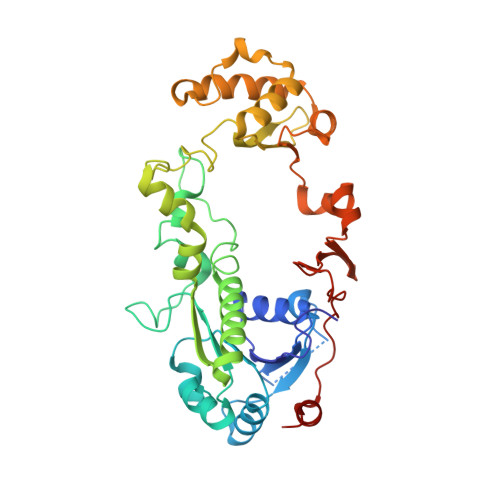The Catalysis of the 1,1-Proton Transfer by alpha-Methyl-acyl-CoA Racemase Is Coupled to a Movement of the Fatty Acyl Moiety Over a Hydrophobic, Methionine-rich Surface
Bhaumik, P., Schmitz, W., Hassinen, A., Hiltunen, J.K., Conzelmann, E., Wierenga, R.K.(2007) J Mol Biol 367: 1145-1161
- PubMed: 17320106
- DOI: https://doi.org/10.1016/j.jmb.2007.01.062
- Primary Citation of Related Structures:
2GCE, 2GCI, 2GD0, 2GD2, 2GD6 - PubMed Abstract:
Alpha-methylacyl-CoA racemases are essential enzymes for branched-chain fatty acid metabolism. Their reaction mechanism and the structural basis of their wide substrate specificity are poorly understood. High-resolution crystal structures of Mycobacterium tuberculosis alpha-methylacyl-CoA racemase (MCR) complexed with substrate molecules show the active site geometry required for catalysis of the interconversion of (2S) and (2R)-methylacyl-CoA. The thioester oxygen atom and the 2-methyl group are in a cis-conformation with respect to each other. The thioester oxygen atom fits into an oxyanion hole and the 2-methyl group points into a hydrophobic pocket. The active site geometry agrees with a 1,1-proton transfer mechanism in which the acid/base-pair residues are His126 and Asp156. The structures of the complexes indicate that the acyl chains of the S-substrate and the R-substrate bind in an S-pocket and an R-pocket, respectively. A unique feature of MCR is a large number of methionine residues in the acyl binding region, located between the S-pocket and the R-pocket. It appears that the (S) to (R) interconversion of the 2-methylacyl chiral center is coupled to a movement of the acyl group over this hydrophobic, methionine-rich surface, when moving from its S-pocket to its R-pocket, whereas the 2-methyl moiety and the CoA group remain fixed in their respective pockets.
Organizational Affiliation:
Biocenter Oulu and Department of Biochemistry, University of Oulu, Linnanmaa, P.O. Box 3000, FIN-90014 University of Oulu, Finland.
















